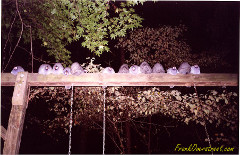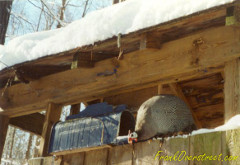Guinea Fowl
I wanted some means of controlling ticks and japanese beetles which were in abundance around my house in Raleigh, North Carolina. I heard that guinea fowl are good for controlling insects while at the same time providing the service of a watch animal. So, I began researching to learn if gardening with guineas was right for me.
I purchased a book titled Gardening With Guineas by Jeannette S. Ferguson which I recommend to anyone considering raising guineas. After reading the book, I was certain I wanted some guineas and found a hatchery which delivered day old keets via overnight express mail.
I was concerned about mailing a live animal but after some research, I realized it is a common practice. The keets arrived safe and sound in a perforated cardboard box labelled "LIVE ANIMALS". The first thing to do was take each keet and dip its beak in some sugar water. As soon as the beak touched the water, they would take a drink. After letting them drink their fill, I placed them inside a cardboard box with a food tray filled with "sporting game feed", water dispenser and a heat lamp.
After about two weeks sitting inside a large box in the garage, I moved them outside to a coop. I wired a heat lamp into the coop to provide nightime warmth. Once large enough to free range, they no longer needed the heat lamp, not even in winter.

Frank Overstreet's guinea fowl roosting on top of the swingset. Once the guineas changed roosts, they never again used their former roost.
Click image to enlarge.
They have to remain inside the coop several weeks in order to grow and set that location as "home". When the big day came to let them outside, they didn't venture too far from the coop and spent the entire day huddled beneath the deck. I was very pleased to see them all return to their coop at dusk.
Each day, they ventured a little farther away from the coop but never far from the house. When anything disturbed them, they would erupt in a noise of such intensity that it was difficult to imagine how an animal the size of a chicken could be so loud. Every evening, they would faithfully return to the coop.
In time, they learned what belonged in the area and what didn't. If they started hollering, you knew a predator, unrecognized human or unrecognized vehicle was near the house. As for me, they considered me to be their mother and would follow me wherever I went. They love following behind the lawnmower for the smorgasbord of insects it stirs up.
During the short days of winter, I couldn't be home at dusk and eventually, they stopped using the coop, choosing instead to roost atop the swingset. Once or twice per year, they will change roost and seemingly never again use an old roost. They like to roost about 10-15 feet above ground and show a preference for mature dogwoods.
The guinea's diet is about 90 percent protein which means just about every time you see their head go down, a bug disappeared from your yard. When moving, their heads go down about once each five seconds! They eat a lot of bugs. Each bird consumes thousands of insects per day. They will also eat seed and some plants, especially hostas. So, if you prize your hostas, guineas may not be right for you. During winter, they scratch quite a bit and I make available "sporting game feed" which they sometimes eat but for the rest of the year, all I provide is fresh water.
Guineas are good fliers but are extremely fast runners. Eventually, the neighbor's dogs gave up hope of ever catching one and would leave them alone. Guineas are a fun and beneficial animal to have for anyone in a semi-rural to rural setting.





